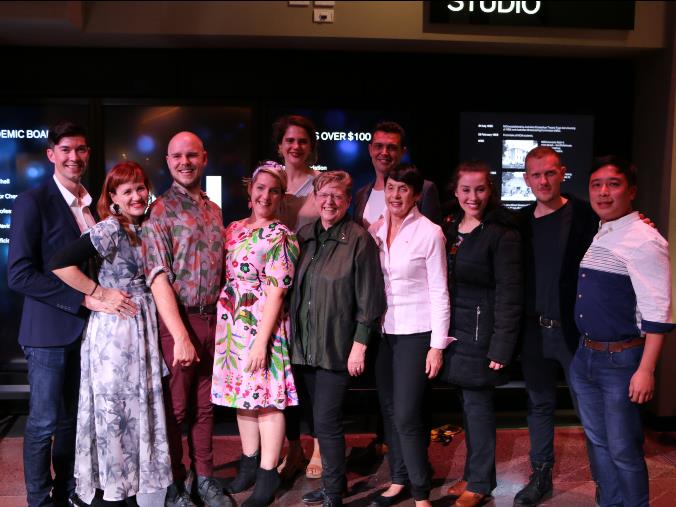The inaugural NIDA MFA (Cultural Leadership) cohort, with Robyn Archer AO FAHA Chair of Cultural Leadership (Centre) and A/Professor Cheryl Stock PhD AM Head of Cultural Leadership (Centre, right). Image supplied.
Two years ago NIDA announced a new two and a half years, part-time Masters course — the Master of Fine Arts, Cultural Leadership.
Designed for mid-career producers, directors and managers already working in the arts, the course steps in at just the right time when prospective students are asking themselves what’s next in their career.
But what makes someone a good cultural leader in the arts? How do you prepare for the requirements of leadership in the arts, which intersect with various areas like sustainability, governance and cultural policy? Now that the first cohort is about to graduate in May this year, we spoke to two students about their experiences and how they define cultural leadership.
Big picture thinking paired with risk-taking
‘Cultural leaders come in many different forms, but for me strong leadership is having the ability to dream big, think outside the square, be willing to take risks and open to all possibilities,’ said Daniel Dunlop, Arts Manager and Creative Learning Specialist.
Behind the big picture, however, often lies internal changes that require a particular set of skills and knowledge base, including an awareness of communication styles and of the different leadership and governance models at play.
It’s also important to know how to balance creative practice with financial responsibilities.
Dunlop completed his placement – which comes towards the end of the two-year MFA in Cultural Leadership – at Cirque du Soleil, where he saw first-hand how one of the largest entertainment companies in the world manages the tensions of creative and artistic practice with powerful corporate and financial priorities. ‘This was particularly revealing in the context of the new investment firm ownership, and the recent changes to leadership and management structures,’ he added.
‘I was able to engage in strategic discussion and big picture planning, and calibrate the core areas of focus within my two-year course of study, in the context of a large-scale commercial arts organisation, during a time of significant change.’
Leave the echo chamber
For Jo Thomas, CEO and Creative Director of Metro Arts, awareness is at the heart of what it means to be a cultural leader.
‘Being aware and informed of what’s going on in our society, our communities, in spheres that are not our own echo chambers. Having an awareness of the inequities and inequalities others experience daily, and considering how we can offer cultural understandings and solutions,’ she said.
‘If you’re not aware of what’s going on you can’t take steps to make change.’
Leaving behind the familiar to find out what’s going on elsewhere led Thomas to undertake a placement with Manchester International Festival (MIF) as part of her studies.
‘I’m interested in the stories we tell and the ways we can shape a city or a neighbourhood. Manchester International Festival (MIF) makes a tremendous impact on the city through its festival and community engagement activities and artist-led processes. The city and the Festival are committed to cultural democracy and that means striving for equity for all cultural voices and stories to be told. The investment in arts and culture in the city is truly inspiring; and the MIF team are at the top of their game. It was a joyous experience – not having to justify the value of arts and culture.’
Make friends and influence people
While cultural leaders can be individuals, cultural leadership in the sector takes a team. Dunlop said finding peers to work alongside offers a great deal of support and inspiration.
‘The group of colleagues I have been able to share the journey with, learn from, form bonds with, and share experience with, is the greatest strength of the program. With such an amazing group of professionals, all working in the industry, from a range of different contexts, art forms, and backgrounds, I feel armed with a network of great minds whom I can stand alongside and lean on, as I approach the next set of challenges in my career,’ he said.
Thomas agreed. ‘The best learning always comes from your peers and spending time debating, discussing and seeing work. The first cohort are an eclectic and powerful group of people who are already doing vital work in our sector,’ she concluded.
Visit nida.edu.au to find out more about the Masters of Fine Art, Cultural Leadership.





